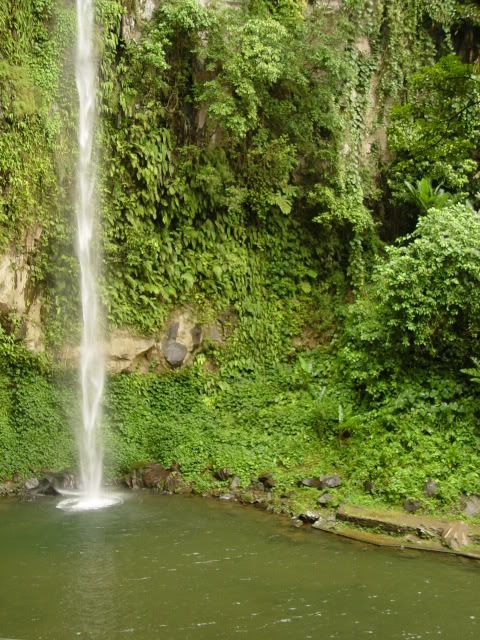Rainclouds Over Camiguin
For the third time in half an hour, George the driver pulled the van over by the side of the coastal highway. “Dat is, uhm, White Island,” he stammered, pointing to a nondescript sandbar in the middle of the bay. “Masarap diyan mag-inuman pag gabi. Gosto nyo mag picture?”
Perhaps a water-logged rainy day wasn’t the best time to visit the island of Camiguin, best known for its sunny beaches, but it was the penultimate day of my trip to Cagayan and I wasn’t about to let the opportunity pass. George, it was apparent, was eager to show me the sights he deemed interesting and kept stopping at the most unfortunate locations. “Picture kayo?”

We took a sharp left and drove up a sloping road until we reached the entrance to Katibawasan Falls. Literally translated, Katibawasan means Itch Relief. I received a sheet of government stamps as I paid the disinterested ticket seller and hiked up the path. Déjà vu to almost two years ago when I visited the falls at Hinulugang Taktak National Park in Antipolo. Take a spot of natural beauty, add a concrete platform around it, with picnic tables and garbage bins visitors tend to ignore. I was glad to notice that Katibawasan smelled like a fresh spring morning, unlike Hinulugang Taktak which smelled vaguely of chemical rot. Try to block out the “improvements” that make Katibawasan convenient for run-of-the-mill tourists, frame it in your mind so you only visualize that which has been left untouched and Katibawasan is very pretty, narrowly cascading down some seventy meters into a small green pool.

A short drive later and we were at Ardent Hot Springs, the usual jump off point for a trek up Mount Hibok Hibok, a volcano that guidebooks say last erupted in 1951. Why is it that most hot springs in the country have the same attributes? Treacherous mossy paths leading down to public pools of gray concrete and stone and leading up again to dismal dirty toilets with no flush tanks beside grimy-floored changing rooms. It began raining again so I just sat under a leaky thatched roof and ate my tuna sandwich baon.
“How many people live in Camiguin,” I asked George as we drove toward our last two stops. He thought for a while and replied, “tu handred, maybe tree handred.” Thousand, I asked, or maybe families? “No, tree handred pipol.” Surely there were already more than that at the docks where the ferry landed, I thought. It was clear that I was miscommunicating and was secretly turning into a wise-alecky asshole. I shut up and let him continue talking. “Hir in Camiguin, der is no movie haws. Libangan ng mga tao dito, dibidi.”

Just off the west coast of Camiguin is the Sunken Cemetery, which disappeared into the ocean following an earthquake in 1871. It is marked by an enormous cross standing on a platform. You view it from a lookout point beside the circumferential highway. Warning signs inform the visitor to enter at your own risk. Standing there, looking at the Sunken Cemetery feels like you are trespassing.

A few meters down the road from the lookout point are the ruins of a 17th century Spanish church which was destroyed in the same earthquake that submerged the already buried dead. Most of the church is underground and the walls and buttresses that remain visible are overgrown by foliage. Walking into the main hall of the church, I expected to timeshift back into the recent colonial past. I was, instead, assaulted by the sightof a new chapel being constructed in the middle of the ruins. It ruined the ruins. Past one of the side buildings I came upon a magnificent tree, its towering crown resplendent in beauty but marred just above its roots by screaming initials carved into its trunk. Why do we insist on doing things like this?

It started to rain again and as I crawled back into the van. Come here when the sun is out and it’ll be better. At least that’s what I hoped on the ride back to the pier. And thank God for the good lanzones.


